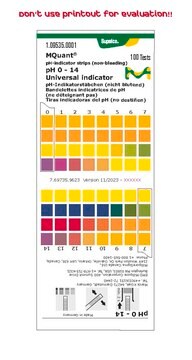28-2950
Sodium hydroxide
SAJ first grade, ≥95.0%
Synonym(s):
‘Caustic soda’
Sign Into View Organizational & Contract Pricing
All Photos(1)
About This Item
Linear Formula:
NaOH
CAS Number:
Molecular Weight:
40.00
MDL number:
UNSPSC Code:
12352106
PubChem Substance ID:
grade:
SAJ first grade
Recommended Products
grade
SAJ first grade
vapor density
>1 (vs air)
vapor pressure
<18 mmHg ( 20 °C)
3 mmHg ( 37 °C)
Assay
≥95.0%
form
solid
availability
available only in Japan
mp
318 °C (lit.)
solubility
water: ~1260 g/L at 20 °C
density
2.13 g/cm3
SMILES string
[OH-].[Na+]
InChI
1S/Na.H2O/h;1H2/q+1;/p-1
InChI key
HEMHJVSKTPXQMS-UHFFFAOYSA-M
Looking for similar products? Visit Product Comparison Guide
Application
- MOF-Enhanced Aluminosilicate Ceramic Membranes Using Non-Firing Processes for Pesticide Filtration and Phytochrome Removal.: This research utilizes sodium hydroxide in the development of MOF-enhanced aluminosilicate ceramic membranes. These membranes are crafted through non-firing processes, highlighting their utility in filtering pesticides and removing phytochromes, offering substantial benefits for environmental management and agricultural applications (Zhao L et al., 2024).
- Assessing the Acidic and Alkaline Recalcitrance of Covalently Modified Surface Amines on Ordered Mesoporous Carbon.: The study examines the resistance of covalently modified surface amines on mesoporous carbon to acidic and alkaline environments, where sodium hydroxide is used to test alkaline recalcitrance. This work is pivotal for applications in catalysis and material science (Kovach NC et al., 2024).
- Formation of plasmonic core/shell nanorods through ammonia-mediated dissolution of silver(i)oxide for ammonia monitoring.: This article discusses the role of sodium hydroxide in synthesizing plasmonic core/shell nanorods. The process involves ammonia-mediated dissolution, which is critical for developing sensors for ammonia detection in environmental monitoring (Ghorbanian E et al., 2024).
- High temperature corrosion and oxide scale formation of nickel in molten NaOH at various basicity levels.: Investigates the corrosion behavior and oxide scale formation on nickel in molten sodium hydroxide. This study is crucial for understanding material degradation in high-basicity environments, which has implications for industrial processes involving caustic substances (Stoffersen B et al., 2024).
- Long-term durability of discarded cork-based composites obtained by geopolymerization.: Focuses on the durability of cork-based composites treated with sodium hydroxide and geopolymerized. This research is significant for waste management and recycling processes, providing insights into sustainable material usage (Poggetto GD et al., 2024).
Signal Word
Danger
Hazard Statements
Precautionary Statements
Hazard Classifications
Eye Dam. 1 - Met. Corr. 1 - Skin Corr. 1A
Storage Class Code
8B - Non-combustible corrosive hazardous materials
WGK
WGK 1
Flash Point(F)
Not applicable
Flash Point(C)
Not applicable
Choose from one of the most recent versions:
Already Own This Product?
Find documentation for the products that you have recently purchased in the Document Library.
Triggered Ca2+ influx is required for extended synaptotagmin 1-induced ER-plasma membrane tethering.
Olof Idevall-Hagren et al.
The EMBO journal, 34(17), 2291-2305 (2015-07-24)
The extended synaptotagmins (E-Syts) are ER proteins that act as Ca(2+)-regulated tethers between the ER and the plasma membrane (PM) and have a putative role in lipid transport between the two membranes. Ca(2+) regulation of their tethering function, as well
Miki Wada et al.
Nucleic acids research, 42(12), 7851-7866 (2014-06-11)
During termination of translation in eukaryotes, a GTP-binding protein, eRF3, functions within a complex with the tRNA-mimicking protein, eRF1, to decode stop codons. It remains unclear how the tRNA-mimicking protein co-operates with the GTPase and with the functional sites on
Yuki Itakura et al.
PloS one, 10(9), e0136660-e0136660 (2015-09-04)
Rhythmic motor patterns underlying many types of locomotion are thought to be produced by central pattern generators (CPGs). Our knowledge of how CPG networks generate motor patterns in complex nervous systems remains incomplete, despite decades of work in a variety
Horacio Cardenas et al.
Epigenetics, 9(11), 1461-1472 (2014-12-04)
A key step in the process of metastasis is the epithelial-to-mesenchymal transition (EMT). We hypothesized that epigenetic mechanisms play a key role in EMT and to test this hypothesis we analyzed global and gene-specific changes in DNA methylation during TGF-β-induced
Label-Free Biosensing with High Selectivity in Complex Media using Microtoroidal Optical Resonators.
Erol Ozgur et al.
Scientific reports, 5, 13173-13173 (2015-08-15)
Although label-free biosensors comprised of optical microcavities inherently possess the capability of resolving molecular interactions at individual level, this extreme sensitivity restricts their convenience for large scale applications by inducing vulnerability towards non-specific interactions that readily occur within complex media.
Our team of scientists has experience in all areas of research including Life Science, Material Science, Chemical Synthesis, Chromatography, Analytical and many others.
Contact Technical Service





